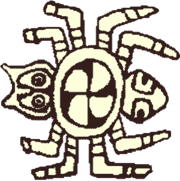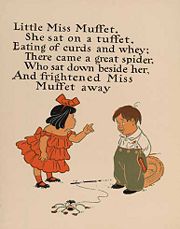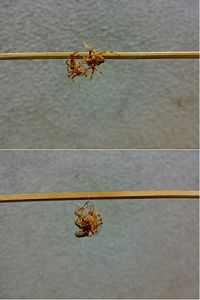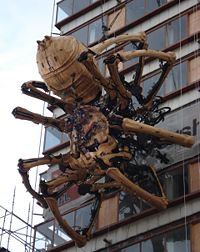Cultural depictions of spiders

Throughout history, there have been many cultural depictions of spiders in popular culture, mythology and symbolism. From Greek mythology to African folklore, the spider has been used in human culture to represent many varied things and indeed endures on into the present day with characters such as Shelob from The Lord of the Rings and Spider-Man from the eponymous comic series. The spider has symbolized patience due to its hunting technique of setting webs and waiting for prey, as well as mischief and malice for its poison and the slow death it causes, its venom often seen as a curse.[1]
Although not all spiders spin webs to hunt prey, they have been attributed by numerous cultures with the origination of basket-weaving, knotwork, weaving, spinning and net making. Webspinning also caused the association of the spider with creation myths as they seem to have the ability to excrete their own artistic worlds.[2] Spiders have been the focus of fears, stories and mythologies of various cultures for centuries.[3]
Contents |
In folklore and mythology
The spider has featured in mythological fables and cultures throughout the world since ancient times and in modern mythology.
In Ancient Egypt, the spider was associated with the goddess Neith in her aspect as spinner and weaver of destiny, this link continuing later though the Babylonian Ishtar and Greek Athena.[4]

The most notable ancient legend that explains the origin of the spider is the story of the weaving competition between the Greek goddess Athena and the princess Arachne. This fable was added much later to the Greek mythos when Ovid wrote the poem Metamorphoses between AD 2-8.[5] Arachne was the daughter of a famous Tyrian purple dyer in Hypaipa of Lydia. Due to her father's skill with cloth dying, Arachne was adept in the art of weaving. Eventually, she began to consider herself a greater weaver than the goddess Athena herself and challenged the goddess to a weaving contest to prove her skill. Athena wove the scene of her victory over Poseidon that had inspired her patronage of Athens, while Arachne wove a tapestry featuring twenty-one episodes of infidelity amongst the Gods of Olympus, which angered Athena. The goddess conceded that Arachne's weaving was flawless but she was infuriated by the mortal's pride. In a final moment of anger, Athena destroyed Arachne's tapestry and loom with her shuttle. Out of sadness, Arachne hung herself soon after. Taking pity on her, Athena transformed her into a spider before the princess could kill herself. Athena made sure that the spider retained Arachne's weaving abilities. The Greek Arachne means "spider" (αράχνη).[6][7]
The scholar Robert Graves proposed the tale may have its roots in the commercial rivalry between the Athenians and Cretan inhabitants of Miletus in Asia Minor, who flourished around 2000 BC and to whom the spider may have been an important figure as seals with spider emblems have been recovered in the city's namesake in Crete.[8]
In African folklore, the spider is personified as Anansi, the trickster god and character from later in African mythology. Alternate names include Kwaku Ananse in West Africa and anglicized as Aunt Nancy (or Sister Nancy), a variant specifically found in some of the islands of the West Indies, South America and the United States.[9] And in other cultures, such as the Native American Lakota people's culture, the spider is present as the deity Iktomi, which is occasionally depicted in its form.[4] In Native American mythology, the spider is again seen in the legend about the birth of the constellation Ursa Major. The constellation was seen as seven men transformed into stars and climbing to paradise by unrolling a spiders web.[1] The Navajo has the creation myth of Spider Grandmother. In the story, Spider Grandmother created all things through the shimmering threads that came out of her belly.[10] The Moche people of ancient Peru worshiped nature.[11] They placed emphasis on animals and often depicted spiders in their art.[12]

The Tsuchigumo (translated as "Earth spiders")[13] of Japan, were both a mythical ethnic group, believed to live in the Japanese Alps until at least the Asuka period, and a mythical, supernatural creature faced by the character Minamoto no Raiko, although the term was also loosely used for bandits and thieves. The Tsuchigumo were said to live in caverns beneath the mountains and the Tsuchigumo in the Minamoto no Raiko legend were able to take the visage of a boy or a woman depending on the version of the story. Minamoto is said to have been lured to a house whilst on a search for a mythical, giant skull and was placed under and illusion by a Tsuchigumo in the guise of a young boy. However, Minamoto breaks this illusion by striking out at the boy with his sword after he suspects foul play. Minamoto discovers he is actually covered in spiders web and after tracking down the boy, learns that he is actually a giant spider, or Tsuchigumo.
In more recent history, the famous legend of the King Robert the Bruce of Scotland depicts a spider as a symbol for hope. Historians are unsure of the legend's truth and agree that it is probably apocryphal, but in the legend Bruce, when fighting the English, took refuge in a cave after a series of military failures. Whilst hiding in the cave he saw a spider, which continued to fail to climb up its silken thread to its web. After repeatedly failing to climb upwards, the spider eventually succeeded due to perseverance. Taking this as a symbol for hope and perseverance, much like the saying "try, try and try again", Bruce came out of hiding. Bruce eventually won Scotland's independence and many cite Rathlin Island as the cave in which this legend took place.[14]
The spider has been compared with vampires as they have similar characteristics. Both lures and ensnare prey before sucking the life out of their victim. Like the arachnids, vampires are believed to be able to scale walls and cliff faces, and possess recognisable fangs, similar to those of spiders.[15]

The spider is also found in modern tales. The nursery rhymes Itsy Bitsy Spider and Little Miss Muffet have spiders as focal characters.
The spider is also depicted in various urban legends. The daddy long legs (Pholcidae) were known as to have a very potent venom but have very short fangs to deliver the poison. However, an episode in Discovery Channel's Mythbusters shown that a host was able to survive a bite from the spider. Another urban myth depicts a young woman who found out that that her beehive hair was infested with Black widow spiders.[16] An email hoax describes the attacks done by the South American Blush Spider in public toilets. The alleged spider's scientific name Arachnius gluteus literally means "butt spider". It should be noted that the hoax spider shares some characteristics with the two-striped telamonia (Telamonia dimidiata)[17]
In literature
The spider has been featured in literature for many centuries. In the Vedic philosophy of India, the spider is depicted as hiding the ultimate reality with the veils of illusion.[10] In the epic poem Ovid's Metamorphoses written about 2 millennia ago. Spiders were also depicted in Dante Alighieri's Purgatorio as the half-spider Arachne,[18] and more recently in books such as the fantasy novel Harry Potter and the Chamber of Secrets by J. K. Rowling.[19] This book was later followed by a motion picture of the same name, using the giant spider Aragog from the novel as a supporting character and pet of Hagrid, a grounds keeper in the book. Again in titles such as The Lord of the Rings, written by J. R. R. Tolkien, the spider takes its form as the menacing giant spider Shelob, and was featured in the film adaption of the last book of the Lord of the Rings series.[20] Tolkien had previously used spiders in his precursor to the Lord of the Rings series with the book The Hobbit. In The Hobbit, giant spiders roamed a great forested area known as Mirkwood and attacked the main characters of the book and capturing some of them.[21] Spiders are a recurring theme in both Tolkien's works and in other authors.[22] The 1952 children's novel Charlotte's Web written by E. B. White, later made into a feature film in 1973 and 2006, is notable in its portrayal of the spider in a positive manner[23] as a heroine[24] rather than an object of fear or horror.
In comics and manga

In graphic novels, spiders are often adapted by superheroes or villains as their symbols or alter ego due to the arachnid's strengths and weaknesses. One of the most notable characters in comic book history which has taken their identity and name from the spider is the Marvel comic book hero Spider-Man. After being accidentally bitten by a radioactive spider, Peter Parker, later known as Spider-Man, was able to scale tall buildings and shoot web fluid from a box attached to his wrist. Along with these abilities came super senses and instant reflexes. The franchise, originally created by the writer Stan Lee and artist Steve Ditko, has become so popular that it has had three successful movies made based on the Spider-Man comic books. Along with Spider-Man, the comic book has also introduced several new characters using the spider as their patron: these include Spider-Woman, Spider-Girl, the Scarlet Spider, Venom, Araña, and the Tarantula. Many other comic book characters have taken the guise of a spider, including Black Spider from the Batman universe,[25] and in manga and anime; In the Pokémon franchise, Spinarak and Ariados are similar to spiders in shape; in the Static Shock series Anansi the Spider.
In film and television
Spiders have been present for many decades in both film and television, predominantly in horror movies, which use them to cause fear, especially amongst those who suffer from arachnophobia; an acute fear of spiders. Many films have featured the spider, including: 1955's Tarantula, made in the midst of America's fear of atomic radiation,[26] Kingdom of the Spiders, a 1977 film starring William Shatner, depicts the spiders attacking humans after their natural food supply was destroyed from pesticides; Arachnophobia, a 1990 movie in which spiders multiply in large numbers and terrorize a group of humans; and more recently, the 2002 blockbuster Eight Legged Freaks in which a group of spiders is mutated from nuclear waste and attacks the nearby town via an underground mine. Film adaptions of books featuring spiders have arisen too, including The Lord of the Rings: The Return of the King's Shelob[20] and Harry Potter and the Chamber of Secrets' Aragog,[19] and of comic books, including the Spider-Man trilogy. In Ingmar Bergman's film Through a Glass Darkly, the psychotic Karin believes she has an encounter with God in the form of a spider.
Other depictions

As the spider further embeds itself into the culture of humans, more and more depictions arise: From nicknames such as "Spider" for the Olympic skier Vladimir Sabich, to gaming depictions such as the solitaire game Spider, to team names such as the Cleveland Spiders and San Francisco Spiders to technological mentions such as the web spider, commonly known as the web crawler.The World Wide Web implies the spider-like connection of information that is accessible in the Internet.[27] Giant spiders appear in a number of role-playing games, such as Dungeons & Dragons,[28][29] and the first edition of Warcraft: The Roleplaying Game, where they are described as "a spider of staggering size—perhaps 15 feet around—with great furred body."[30] Atlach-Nacha is an H-game that revolves around a spider demon disguising herself as a human woman. Even dances, such as the tarantella which is related to the spider Lycosa tarantula and the actual fighting of spiders, such as in the Philippines[31] and Japan.[32] Even as tattoos, spiders serve a visible symbolic significance in popular culture.[33] In September 2008 a giant mechanical spider La Princesse was in Liverpool as part of a French performing arts company spectacle.
References
- ↑ 1.0 1.1 Garai, Jana (1973). The Book of Symbols. New York: Simon & Schuster. ISBN 671-21773-9.
- ↑ De Laguna et al, Frederica (2002). American Anthropology: Papers from the American Anthropologist. University of Nebraska Press. pp. 455. ISBN 080328280X. http://books.google.com/books?id=XIFX-sSYURwC&pg=PA455&dq=Spider+creation+myth&sig=RI0W9BNC-E36_Le7G2bMvhbjQNw. Retrieved on 2008-04-21.
- ↑ De Vos, Gail (1996). Tales, Rumors, and Gossip: Exploring Contemporary Folk Literature in Grades 7-12. Libraries Unlimited. pp. 186. ISBN 1563081903. http://books.google.com/books?id=M8bvN93y-fIC&pg=PA186&dq=spiders+folklore+and+mythology&lr=&ei=HHsNSNGgNZOKsgO2sqnHAQ&sig=rfYxr-r7pktGmHuA31vEUL99rn8. Retrieved on 2008-04-22.
- ↑ 4.0 4.1 Cooper, JC (1992). Symbolic and Mythological Animals. London: Aquarian Press. pp. 214-15. ISBN 1-85538-118-4.
- ↑ Ovid Metamorphoses ( (vi.5-54 and 129-145), also mentioned in Virgil's Georgics, iv, 246.
- ↑ Evans, C.; Anne Millard (1985). Usbourne Illustrated Guide to Greek Myths and Legends. Usbourne Publishing. pp. 15. ISBN 0860209466.
- ↑ Mills, A. (2003). Mythology: Myths, Legends & Fantasies. Australia: Global Book Publishing Pty Ltd. pp. 62-64. ISBN 073361499X.
- ↑ Graves, R (1955). "Athene's Nature and Deeds". Greek Myths. London: Penguin. pp. p. 100. ISBN 0-14-001026-2.
- ↑ Mills et al, Mythology: Myths, Legends & Fantasies, pp. 317.
- ↑ 10.0 10.1 Cicchetti, Jane (2003). Dreams, Symbols, and Homeopathy: Archetypal Dimensions of Healing. North Atlantic Books. pp. 50. ISBN 1556434367. http://books.google.com/books?id=0al1ZZtrnrsC&pg=PA50&dq=Spider+Grandmother+navajo+creation&sig=W6n0H0fCRwBZT6ni66BYJ3V5Dvc. Retrieved on 2008-04-21.
- ↑ Benson, Elizabeth, The Mochica: A Culture of Peru. New York, NY: Praeger Press. 1972
- ↑ Berrin, Katherine & Larco Museum. The Spirit of Ancient Peru:Treasures from the Museo Arqueológico Rafael Larco Herrera. New York: Thames and Hudson, 1997.
- ↑ Hudson, Mark (1999). Ruins of Identity: Ethnogenesis in the Japanese Islands. University of Hawaii Press. pp. 201. ISBN 0824821564. http://books.google.com/books?id=eTFMPO5NdKgC&pg=PA201&dq=Tsuchigumo&sig=Qw7yIIkLvgmND402T_eR0TkL4rw.
- ↑ Farndon, J. (2001). 1000 Facts On Modern History. Essex: Miles Kelly Publishing Ltd. pp. 18-19. ISBN 184236054X.
- ↑ Bunson, M. (1993). The Vampire Encyclopedia. London: Thames & Hudson Ltd.. pp. 243. ISBN 0-500-277486.
- ↑ Holt, David. "The Belle at Biloni". Spiders in the Hairdo: Modern Urban Legends. august house. pp. 70. ISBN 0874835259. http://books.google.com/books?id=jCaO3LaHk8kC&pg=PA70&dq=spider+urban+legends&lr=&sig=FoXo1q5YXEDwfIZIeuE8jOUfAqo. Retrieved on 2008-04-22.
- ↑ Snopes: Urban Legends Reference Pages: Two-Striped Telamonia Spider. Retrieved 2007-02-25.
- ↑ Alighieri, Dante. "Purgatorio, Canto XII". Divine Comedy. http://en.wikisource.org/wiki/The_Divine_Comedy/Purgatorio/Canto_XII. Retrieved on 2008-04-21.
- ↑ 19.0 19.1 Rowling, J. K. (1998). Harry Potter and the Chamber of Secrets. Bloomsbury Publishing Plc. ISBN 0747538484.
- ↑ 20.0 20.1 Tolkien, J. R. R. (1994). The Lord of the Rings. London: Harper Collins Publishers. ISBN 0261103202.
- ↑ Tolkien, J. R. R. (1974). The Hobbit. London: Unwin Books. ISBN 0048230707.
- ↑ Day, D. (2002). A Tolkien Beastiary. London: Chancellor Press. pp. 220-221. ISBN 0753704595.
- ↑ Scholastic Inc.. Bridge to Terabithia. Scholastic. pp. 18. ISBN 0439411297. http://books.google.com/books?id=z5__TflJWZwC&pg=PA18&dq=charlotte%27s+web+arachnophobia&sig=GCHc0rbPG5xJU39cqWE3oquaXT0. Retrieved on 2008-04-21.
- ↑ Boga, Steven (1995). Camping and Backpacking With Children. Stackpole Books. pp. 154. ISBN 0811725227. http://books.google.com/books?id=t1mPn3apl6AC&pg=PA154&dq=charlotte%27s+web+arachnophobia&sig=FOaQbbPnWq-eTh2nLngE9xid_kc. Retrieved on 2008-04-21.
- ↑ Moench; Jones & Beatty (May 1995). 'Batman #518. DC Comics.
- ↑ Searles B (1988). Films of Science Fiction and Fantasy. New York: Harry N. Abrams. pp. p. 109-10. ISBN 0-8109-0922-7.
- ↑ Dale, Nell; John Lewis (2006). Computer Science Illuminated. Jones & Bartlett Publishers. pp. 505. ISBN 0763741493. http://books.google.com/books?id=kGXRzbS3UO0C&pg=PA505&dq=world+wide+web+spider&lr=&sig=xkIuVBJHppINK0dR6HFqc7OJt6A. Retrieved on 2008-04-21.
- ↑ Gygax, Gary (1977). Monster Manual. TSR, Inc..
- ↑ Skip Williams, Jonathan Tweet, and Monte Cook Monster Manual (Wizards of the Coast, 2000)
- ↑ Borgstrom, R. Sean; et al. (2003). Manual of Monsters. White Wolf, Inc.. ISBN 978-1588460707.
- ↑ Espejo, Edwin G. (2005-10-28). "Games big boys play". Sun.Star General Santos. Retrieved on 2007-05-18.
- ↑ Sekine, M. "Not A Cockfight But A Spider-Fight: Kajiki". Retrieved on 2007-08-22.
- ↑ Spider Tattoos
|
||||||||||||||||||||